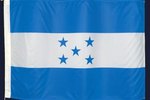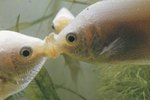
The bala shark gets its name from its resemblance to the ocean's predatory sharks. The bala is actually a bony freshwater fish not related to sharks. Its body is sleek, though, and it has the same fin placement as the saltwater shark's. The bala shark has another thing in common with Jaws: It isn't a picky eater.
Amount
The bala shark is an eager eater. Overfeeding this species is common, as bala sharks jump and act excited when being fed. Humans often interpret this activity to mean the fish need more food -- or they overfeed because it's fun to watch. Feeding two smaller meals per day is recommended over one large meal. Using a timer during feedings to limit the feeding period between three and five minutes is a useful guide.
Basic Diet
Bala sharks are omnivores -- meaning they will eat just about any food source offered. High-quality dried flakes and granules that do not have gluten-type fillers are a basic recommendation. Select dried flakes that contain spirulina algae and fish meal as well as ingredients from both plant- and animal-based food products.
Something Extra
Live and frozen foods such as bloodworms, brine shrimp and other small crustaceans provide the healthy protein bala sharks need to continue growing. Larger bala sharks can eat earthworms, prawns and mussels. Thaw frozen foods in a cup of water from the bala's tank to make it easier for him to eat his food. Shelled peas, blanched spinach and chopped fruits make excellent extras to add to his diet from plant-based food sources.
Additional Feeding Information
In the wild, bala sharks eat insects and their larvae. They especially prefer mosquitoes and daphnia -- better known as water fleas. They also eat phytoplankton and algae. They often scavenge their tanks for live algae and any other food leftover from previous feedings that has settled to the bottom.
References
Photo Credits
-
Hemera Technologies/AbleStock.com/Getty Images
Writer Bio
Amy M. Armstrong is a former community news journalist with more than 15 years of experience writing features and covering school districts. She has received more than 40 awards for excellence in journalism and photography. She holds a Bachelor of Arts in communications from Washington State University. Armstrong grew up on a dairy farm in western Washington and wrote agricultural news while in college.



